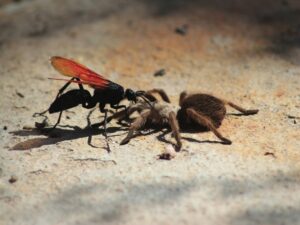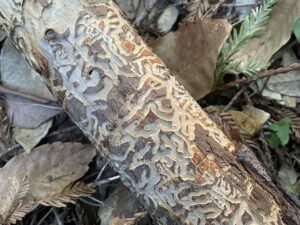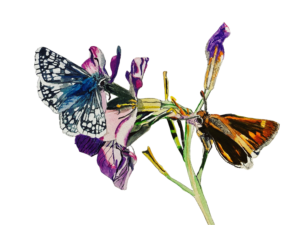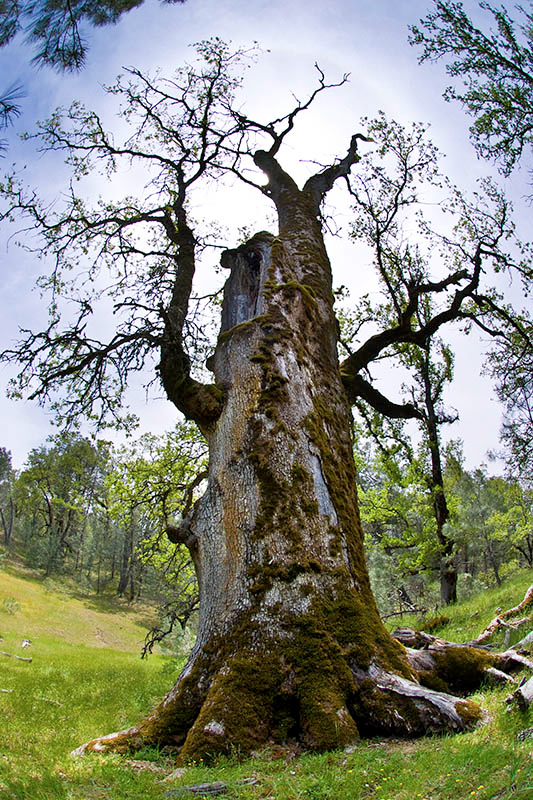
It stands there today as it has for over 400 years, atop a knoll near the highest part of the Ohlone Regional Wilderness, its presence mute testimony to nature’s tenacity and diversity. It has stood there silently through snowstorms, droughts, branch-breaking winds, and 105-degree summer days. It was there when Ohlone Indians climbed the hills collecting acorns and herbs and hunting rabbits and deer. It was there when elk, antelope, and condors roamed the terrain. Its branches have supported countless bird nests and served as daytime roosts for hawks and eagles and nighttime roosts for owls. In its lifetime, it has fed thousands of insects, birds, squirrels, and deer. Now, it has become a “grandfather tree,” ancient and venerable, a monarch of unheralded stature. I call it “Old Blue.”
I first visited this blue oak back in the ’80s and was struck by its size — nearly 100 feet tall and 48 feet across — and its tortured look and slightly asymmetrical lean, caused by the loss of two major limbs many years earlier. I sat on the hillside about 50 yards away and stared at the tree wondering about all that had taken place over the centuries of Old Blue’s life. While this aging giant is remarkable in its own right, it has also come to symbolize for me the ways in which mature blue oaks serve as an anchor for so many other living things. After 40 years of fieldwork in oak woodlands, I’ve come to see that each tree is a universe in itself.

I was first drawn to blue oaks in the late 1960s when I began studying the diversity of cynipid wasp galls found on oaks. I was intrigued by the varied shapes and colors of these otherworldly growths, formed by different species of cynipid wasps. Each species of wasp engenders a gall with its own characteristic shape, size, and color. These tiny wasps are the premier Lilliputian architects of the oak universe, responsible for the construction of larval nurseries shaped like cups, saucers, goblets, bowls, clubs, stars, sea urchins, and other forms without name. As if the geometry weren’t remarkable enough, the galls come in hues of purple, rose, orange, and yellow — sometimes all on a single gall.
California’s 22 species of oaks — half of which can be found on lands managed by the East Bay Regional Park District — are known to support over 200 species of cynipid gall wasps, more recorded species than North Africa, Europe, and Asia combined. No other group of trees in North America supports as many gall insects as do oaks, with more than 800 species of cynipids known. Even within the oak genus, each particular cynipid is associated with just one of the three recognized subgenera of North American oaks — white, black, and intermediate. Wasps that induce galls on coast and interior live oak (both black oaks) do not occur on canyon live oak or huckleberry oak (intermediate oaks). Likewise, many cynipids are limited to valley, blue, scrub, and other “white oaks” and do not occur on canyon live oaks (and related species) or coast live oaks (and related species). Palmer’s oak, an intermediate oak mostly found in Southern California, supports its own unique variety of cynipid wasps, many of them new species still to be scientifically described. A small, isolated stand of Palmer’s oaks grows on a ridge at Vasco Caves Regional Preserve in southeastern Contra Costa County.
Blue oaks are the real stars of this gallant parade of gall wasps. They support the largest number of known species (41) as well as the most bizarre designs and color combinations of any oak galls. Each year, new species are discovered, so every time I drive past blue oak woodlands, I am tempted to stop and see what I can find. During one short stop last summer near Redding, I found two new species not previously known to science.

The life cycle of gall wasps hinges on a near miracle of timing. Since adult gall wasps live only about a week and don’t eat during that time, their most important task is to find the proper host organ (a bud, leaf, or new stem) and lay eggs in it. This means that the adults’ emergence must coincide with the proper stage in the development of the host tree species. The tree’s development varies with the weather, so the wasps’ must as well. When the time is right, a female deposits an egg and also injects a chemical into the tree that causes it to form a nutritive shell around each egg. Nothing else happens until the egg hatches within that nutritive shell, on which the larva begins to feed. In the process, it releases a compound that induces the host to produce a larval nursery of specific size, shape, and color for each species of wasp. Much research has been done to determine the exact nature and causes of species-specific gall formation. Scientists suspect that these tiny wasps are able to manipulate genes in specific plant tissues, inducing the plant to create galls characteristic of their species. But the exact mechanism for this process remains a mystery and has become something of a holy grail for entomologists.
For some wasps, simply creating a protective gall around the larva is not enough. During the early stages of larval growth, many gall wasp species are particularly vulnerable to parasitism or attack by other predators. Some wasps have evolved a further protection besides the gall itself: These larvae convert normal plant starches to sugar and the gall exudes this honeydew in copious quantities. The sweet liquid attracts hordes of ants, bees, and yellow jackets. While feeding, these naturally pugnacious insects prevent any other insects from gaining access to the galls, thereby significantly reducing predation. So the tiny wasp has enlisted at least two species in its defense: the oak that grows the gall and produces the honeydew, and the ants or wasps that defend the gall against parasites. The “guardian insects” do get food out of the deal, but the plant apparently gains nothing. A few years ago, I found a blue oak swarming with large black ants, all marching to the outer branches where galls of the Disholcaspis canescens wasp were developing. I watched for over 30 minutes and nothing else got anywhere near those galls, not even much larger yellow jackets.

Though the trees don’t seem to benefit, they don’t seem to suffer noticeably either. During a field trip last summer, I stopped at a highway pullout and found a three-foot-high blue oak sapling that had already suffered through several seasons of heavy pruning by deer. This squat little tree had only about 200 leaves, but the underside of each and every one supported three to six reddish urchin galls of the wasp Antron quercusechinus. The whole sapling took on a rose-purple hue, looking more like an intentionally decorated Christmas tree than a naturally occurring native.
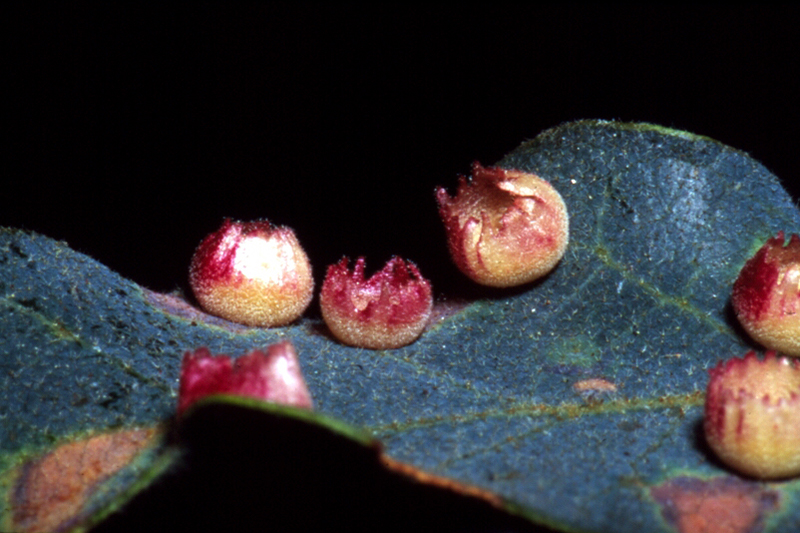
This urchin gall wasp’s life cycle also relies on close synchrony with the growth of the host oak tree. The larvae stop feeding and go to sleep in a pre-pupal form before the leaves turn brown and drop in the fall. By this time the galls are extremely hard (I once broke a scalpel trying to cut a cross section of one). Some galls fall with the leaves, while others drop off with the help of wind or birds. In any event, once on the ground, the larvae–despite being encased in exceptionally hard galls–are vulnerable to mice and woodrats that can find tender morsels of protein inside. The following spring, larvae that survive their winter in the leaf duff hatch out as adults just about the time the blue oaks above them begin to develop leaf buds.

On the east side of Briones Regional Park, in the late 1980s, I found a blue oak that stood about 30 feet high and looked quite healthy. But this tree supported a huge population of the cynipid wasp Andricus kingi. Its red, cone-shaped galls covered every leaf that I could see — all the way up into the canopy, a dozen or more galls on each leaf. I calculated that a modest-size tree with 10,000 leaves could easily support 120,000 gall wasps of just this one species, excluding any other gall insects and their associates. Then by adding conservative ratios of gall parasites, hyperparasites (insects that attack parasites), and inquilines (insects that eat gall tissues, but will often kill any insects they confront inside the galls), I arrived at the astonishing number of just under 200,000 insects using one blue oak as a result of A. kingi galls and larvae. Even if these numbers are conservative and reached only during cycles when populations for a species are at their highest, perhaps once every five to 10 years, the ecological significance of a single blue oak — and blue oak woodlands — begins to come into focus.
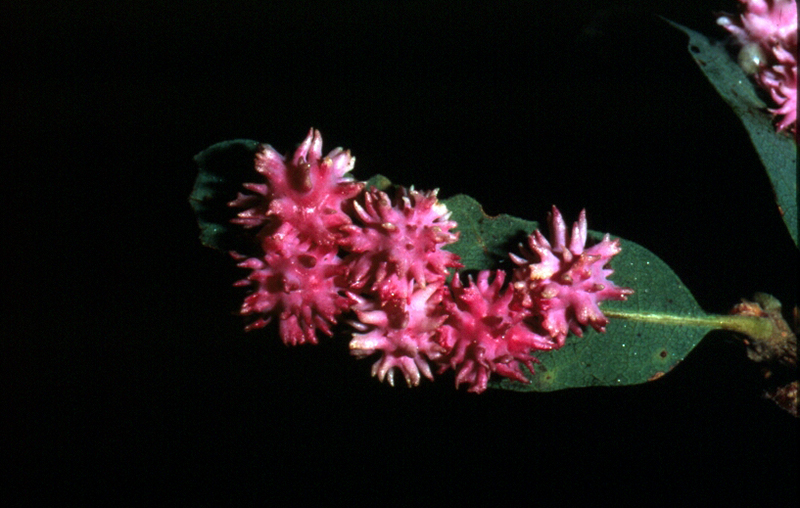
If we then look at the almost incalculable numbers of resident spiders, mites, springtails, moths, beetles, acorn weevils, flies, and other organisms that are found in the cracks and crevices of bark, under or on top of leaves, or on the trees’ flowers, we find many creatures that spend their entire lives, generation after generation, on the same tree without ever venturing elsewhere. And, in turn, these oak-dependent insects and arachnids act as magnets that attract hundreds, perhaps thousands, of birds every year. Our oak woodlands are home to vast numbers of kinglets, vireos, chickadees, warblers, flycatchers, nuthatches, creepers, and many other insect-eating birds that search the branches and leaves for this nutritious bounty.

And that’s just part of the picture. While not every blue oak is used the same way, golden eagles, hawks, and owls will nest or temporarily roost in select trees, keeping an eye out for the ground squirrels that eat the oak’s acorns. Sharp-shinned hawks capture the kinglets, vireos, and other small birds that forage in the oaks. Bobcats and gray foxes will climb into the tree’s branches to rest or hunt those same birds. Turkeys and deer are drawn to many kinds of oaks, including blues, for acorns, a key part of their diets in the fall. A single blue oak becomes a forest within a forest that has far-reaching impacts on the natural community as a whole.

It has been estimated that there are over 3 million acres of blue oak woodland in California. From the gall wasps on up to the vireos, eagles, and deer, blue oaks may be the grand champions of wildlife benefactors. Unfortunately, the temperate foothills of central California favored by blue oaks have also been much coveted by developers of subdivisions, malls, and vineyards. The clearing of these woodlands has resulted in not just the loss of the trees, but the disruption of the entire ecological web with millions of organisms that they support.
Even in the grand company of a blue oak woodland, “Old Blue” stands out. Until 2001, it was the largest known blue oak in California (a larger tree was discovered in 2001 in Three Rivers near Sequoia National Park). According to Sunol naturalist Katie Colbert, when ranger Gene Lagel nominated the tree to the California Register of Big Trees in 1971, it measured 94 feet tall with a trunk circumference of 243 inches and a crown width of 48 feet. Storms and time have altered its height and crown spread, and Old Blue is a slow-growing tree — the trunk is now 256 inches, an increase of just 13 inches in 38 years. While its proverbial 15 minutes of fame lasted for 30 years, it still stands as the core of a small ecological universe, continuing to support countless generations of insects, birds, reptiles, and mammals.
Someday, perhaps in the middle of a starry night, or on a sunny Sunday morning, or during a raucous, unforgiving storm, this giant of a tree, this beaten, old, twisted survivor, will fall and fruit no more. If it should fall in my lifetime, I will no doubt feel a certain loss of kinship. But that it has stood for so long and served so many is a gift of the grandest kind. What a privilege to have seen it and know that it has endured since the times when elk and antelope stood in its shade and Indians harvested its acorns. When it falls, a window into a past long gone will close forever.

